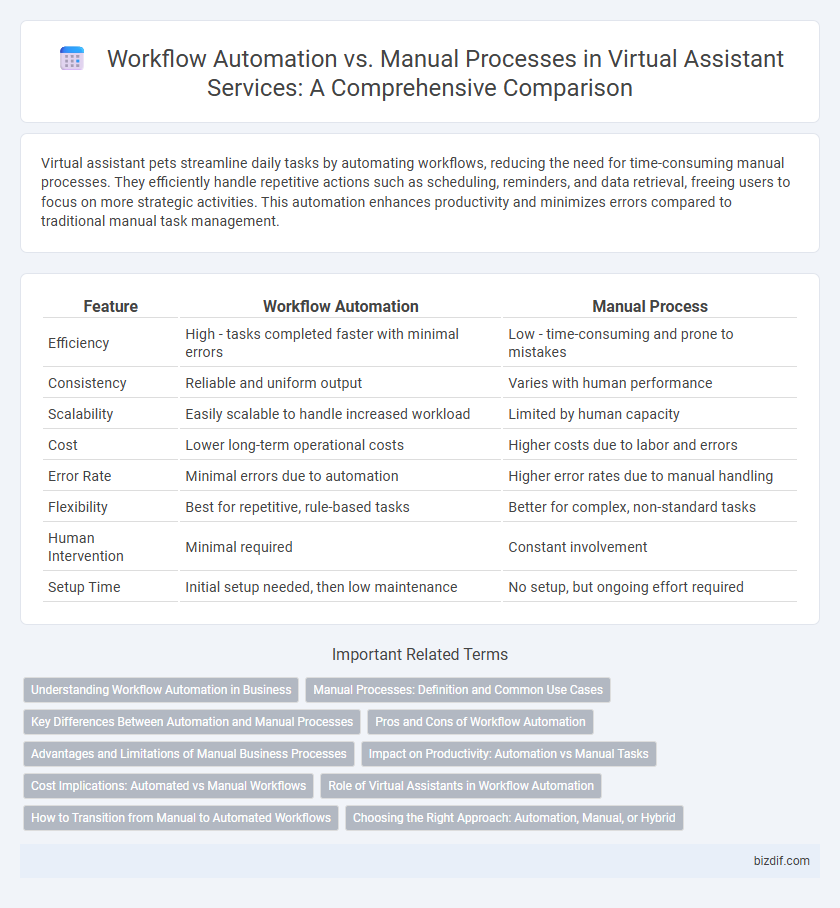Virtual assistant pets streamline daily tasks by automating workflows, reducing the need for time-consuming manual processes. They efficiently handle repetitive actions such as scheduling, reminders, and data retrieval, freeing users to focus on more strategic activities. This automation enhances productivity and minimizes errors compared to traditional manual task management.
Table of Comparison
| Feature | Workflow Automation | Manual Process |
|---|---|---|
| Efficiency | High - tasks completed faster with minimal errors | Low - time-consuming and prone to mistakes |
| Consistency | Reliable and uniform output | Varies with human performance |
| Scalability | Easily scalable to handle increased workload | Limited by human capacity |
| Cost | Lower long-term operational costs | Higher costs due to labor and errors |
| Error Rate | Minimal errors due to automation | Higher error rates due to manual handling |
| Flexibility | Best for repetitive, rule-based tasks | Better for complex, non-standard tasks |
| Human Intervention | Minimal required | Constant involvement |
| Setup Time | Initial setup needed, then low maintenance | No setup, but ongoing effort required |
Understanding Workflow Automation in Business
Workflow automation in business leverages software tools to streamline repetitive tasks, significantly reducing errors and saving time compared to manual processes. Automating workflows enhances operational efficiency by enabling real-time data tracking, seamless communication, and consistent task execution. Businesses using workflow automation report increased productivity, faster turnaround times, and improved employee focus on strategic activities.
Manual Processes: Definition and Common Use Cases
Manual processes involve human intervention to complete tasks without automation, relying on physical actions or manual data entry. Common use cases include customer service interactions, data validation, and approvals in industries like healthcare, finance, and retail. These processes often result in slower task completion and higher error rates compared to automated workflows.
Key Differences Between Automation and Manual Processes
Workflow automation leverages software and AI to execute repetitive tasks with high efficiency, reducing human error and saving time. Manual processes rely on human intervention for task completion, which can lead to slower execution and increased risk of inconsistencies. Key differences include scalability, accuracy, and the ability to integrate with multiple systems for seamless operations.
Pros and Cons of Workflow Automation
Workflow automation significantly increases efficiency by reducing human error and accelerating task completion, which enhances productivity in virtual assistant operations. However, it requires initial investment in technology and may lack the flexibility and nuanced decision-making that manual processes offer in complex scenarios. Balancing automation with human oversight ensures that routine tasks are streamlined while maintaining adaptability and personalized user interactions.
Advantages and Limitations of Manual Business Processes
Manual business processes offer greater control and customization as tasks are handled by human judgment, allowing flexibility in complex decision-making scenarios. However, these processes are time-consuming, prone to human error, and lack scalability, leading to inefficiencies in handling repetitive or high-volume tasks. Workflow automation significantly reduces errors and accelerates task completion, but manual processes remain essential for creative problem-solving and tasks requiring nuanced understanding.
Impact on Productivity: Automation vs Manual Tasks
Workflow automation significantly boosts productivity by streamlining repetitive tasks and reducing human error, allowing virtual assistants to focus on higher-value activities. Manual processes, while flexible, often slow down operations due to time-consuming data entry and increased risk of mistakes. By integrating automation, businesses experience faster task completion, consistent output, and improved overall efficiency, enhancing productivity levels beyond manual capabilities.
Cost Implications: Automated vs Manual Workflows
Automated workflows significantly reduce operational costs by minimizing human intervention and error rates, leading to faster task completion and lower labor expenses. Manual processes often incur higher costs due to repetitive tasks, longer completion times, and increased chances of mistakes requiring costly revisions. Investing in workflow automation enhances cost efficiency, scalability, and overall resource allocation for businesses.
Role of Virtual Assistants in Workflow Automation
Virtual assistants streamline workflow automation by executing repetitive tasks such as scheduling, data entry, and customer support, significantly reducing human error and time consumption. Their integration with software platforms enables seamless communication between applications, enhancing operational efficiency and allowing teams to focus on strategic activities. Empowering businesses with real-time data processing and task management, virtual assistants transform manual workflows into automated, scalable processes.
How to Transition from Manual to Automated Workflows
Transitioning from manual processes to workflow automation involves mapping current tasks to identify repetitive and time-consuming steps suitable for automation. Implementing virtual assistants equipped with AI capabilities streamlines data entry, task scheduling, and communication, significantly reducing human error and operational delays. Gradual integration of automated tools alongside ongoing employee training ensures a smooth shift, optimizing productivity and enhancing scalability within business operations.
Choosing the Right Approach: Automation, Manual, or Hybrid
Workflow automation significantly reduces human errors and accelerates repetitive task completion, enhancing productivity in virtual assistant environments. Manual processes offer flexibility and personalized control for complex or nuanced tasks that automation cannot easily replicate. A hybrid approach combines the efficiency of automation with the adaptability of manual intervention, optimizing operational effectiveness in diverse virtual assistant applications.
Workflow automation vs Manual process Infographic

 bizdif.com
bizdif.com